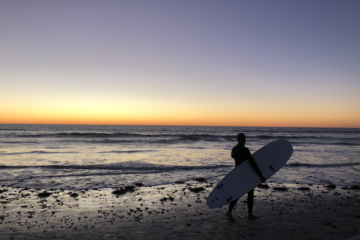Just What Makes a Surfboard Sustainable?
Listen to an audio version of this story by Chris Cheshire:
If you’ve been in the market for a surfboard in the past couple of years, you may have noticed a small black logo glassed into some of the boards. It looks like the outline of two surfboards conjoined, the tracing ending with arrows. Below the boards, bold capital letters read “ECOBOARD.” That logo is one of the ways Sustainable Surf, a nonprofit founded in 2011, is trying to push the surf industry toward environmentalism.
“Our mission,” founder Kevin Whilden said, “is to help surfing become a force to protect the ocean, and by surfing we mean surf culture.”
According to Whilden, surf culture extends beyond just surfers to surf companies, surfboard builders, pro surfers, surf media, and even surf academics. The Ecoboard project is the most visible of the nonprofit’s operations. It’s a way to certify that surfboards have been manufactured with environmental repercussions in mind.
“Essentially, it’s like organic food but for surfboards,” Whilden explained.
There are different levels– currently “Level One” and “Gold Level”– that certify the board contains a certain level of biocarbon based material.
Level One certified boards must be made with a plant-based resin that’s at least 19 percent bio-carbon content or be made from a core that’s at least 25 percent recycled or plant-based content. A Gold certified Ecoboard must be made with one material that has been specifically vetted and approved by Sustainable Surf as “Gold Level” along with one other certified material. Both must also come from an Ecoboard certified builder.
One such builder is Channel Islands Surfboards. Channel Islands’ director of production, Aaron Smith, says getting certified can be quite a process.
“They send an auditor in to go around our facility and confirm that we store the proper chemicals, that we’re not just using whatever,” he said. “Even deeper than that the safety of your factory, the cleanliness, that you’re not polluting with dust or other things. It’s a pretty intensive audit that they do.”
But despite the difficulty of obtaining the certification, Smith says Channel Islands’ customers don’t really care if their boards are Ecoboards.
“Nobody really goes out and hunts [for Ecoboards]. You’re talking maybe, not even one percent of Epoxy customers are out there actively asking for it,” he said.
Channel Islands launched a model specifically for the Gold level certification, but Smith said it didn’t sell. He also worried that Sustainable Surf isn’t doing enough to recognize companies that are taking other approaches to lessen their impact on the environment.
“It’s kinda like they just picked 5 or 6 things to target when there’s 30 things that can benefit the environment if you do them properly,” he said.
For example, he brought up that US Blanks switched their entire factory to solar power and worked on their manufacturing process to cut waste. They then approached Sustainable Surf about getting certified.
“They were like ‘No, no, that doesn’t fit within our thing,’” Smith said. “It was kinda disappointing because if I were to use a US Blank with a UV cure and polyester resin I would be cutting greenhouse emissions almost as much as using their enviro-resin.”
US Blanks one of the largest manufacturers of surfboard blanks in the United States, but most of their blanks use polyurethane foam instead of EPS, which is not recyclable. The only blanks certified by Sustainable Surf that can count toward being Ecoboard certified are Marko Foam blanks, which are made of recycled EPS. Surfboard building supply store Foam EZ carries both kinds of blanks and environmentally friendly resin. Brad Nadell, the owner, said that it’s a rare customer that comes in with environmental impact on their mind. He said Marko foam blanks sell at a rate of about one in ten when compared to normal blanks.
“It takes a specific kind of customer who’s looking for that, I think,” he said.
Despite the fact that Ecoboard certification and environmental materials haven’t affected your average surfer or home builder, Smith says that Sustainable Surf has a good job influencing them and the board manufacturing industry.
“We’ve taken the initiative to work hard in bettering the environment the best we can,” he said. “[Sustainable Surf] really has helped push that in us. Without those guys doing what they do, we probably wouldn’t have done that. It’s a good reminder of ‘Hey, what are you doing for the environment’ and make you think about it and make better decisions.”
Sustainable Surf also runs a few other projects that work with the Ecoboard certification, notable the Waste to Waves program, which designates collection spots (one of which is Foam EZ) for EPS foam that Marko foam uses to make their surfboard blanks.
While the Ecoboard project is meant to reduce surfers’ impact on the environment, Whilden says the immediate goal for Sustainable Surf is to get surfers to help regenerate the ocean. They hope their current focus, SeaTrees, will achieve that. SeaTrees is an online marketplace that sells items whose profits will be used to fund projects like mangrove planting and kelp reforestation and is scheduled to launch on World Oceans Day, or June 8, 2019.


